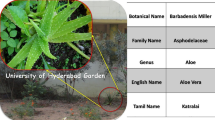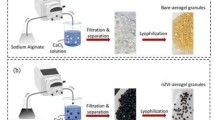Abstract
The development of environmentally friendly, operationally simple, and easily separable adsorbents for uranium removal from wastewater holds significant importance. The biopolymer gelatin (Gel) derived from animal collagen has poor water stability, limiting its application in wastewater treatment. By in-situ compositing with ZIF-67, a nitrogen-rich and stable metal–organic framework structure introduced onto the surface of gelatin fibers enhanced the uranium adsorption capacity of gelatin nanofibers and improved the water stability of these fibers. Furthermore, through the natural polyphenolic tannic acid tanning process, it is possible to further increase selectivity of gelatin composite fibers. The gelatin composite nanofibers Gel/ZIF-67 and T-Gel/ZIF-67 were characterized using SEM, FT-IR, XRD, XPS, and contact angle. Adsorption of uranium on both nanofibers were significantly influenced by pH but minimally affected by ionic strength, indicating the inner-sphere surface complexation. The adsorption of uranium onto Gel/ZIF-67 and T-Gel/ZIF-67 followed the Langmuir isotherm model, with theoretical adsorption capacities reaching up to 608.21 mg g−1 and 612.24 mg g−1, respectively. Kinetic modeling analysis revealed that chemical adsorption played a dominant role during the adsorption processes.














Similar content being viewed by others
Data availability
Data will be made available on request.
References
Abney CW, Mayes RT, Saito T et al (2017) Materials for the recovery of uranium from seawater. Chem Rev 117(23):13935–14013
Edwards C, Oliver A (2000) Uranium processing: a review of current methods and technology. Jom 52:12–20
Anke M, Seeber O, MüLLER R et al (2009) Uranium transfer in the food chain from soil to plants, animals and man. Geochemistry 69:75–90
Dulama M, Iordache M, Deneanu N (2013) Treatment of uranium contaminated wastewater–a review
Banala UK, Das NPI, Toleti SR (2021) Microbial interactions with uranium: towards an effective bioremediation approach. Environ Technol Innov 21:101254
Pardoux R, Sauge-Merle S, Lemaire D et al (2012) Modulating uranium binding affinity in engineered calmodulin EF-hand peptides: effect of phosphorylation. PLoS ONE. https://doi.org/10.1371/journal.pone.0041922
Schnug E, Lottermoser BG (2013) Fertilizer-derived uranium and its threat to human health. Environ Sci Technol. https://doi.org/10.1021/es4002357
Gao M, Zhu G, Gao C (2014) A review: adsorption materials for the removal and recovery of uranium from aqueous solutions. Energy Environ Focus 3(3):219–226
Ma Y, Qi P, Ju J et al (2019) Gelatin/alginate composite nanofiber membranes for effective and even adsorption of cationic dyes. Compos B Eng 162:671–677
Chen J, Song Y, Sheng Y et al (2017) Luminescence properties and Judd-Ofelt analysis of SiO2: Ln3+ (Eu, Tb) hollow nanofibers fabricated by co-axial electrospinning method. J Alloy Compd 716:144–155
Wang N, Pang H, Yu S et al (2019) Investigation of adsorption mechanism of layered double hydroxides and their composites on radioactive uranium: a review. Acta Chim Sinica 77(2):143
Chen L, Zhao D, Chen S et al (2016) One-step fabrication of amino functionalized magnetic graphene oxide composite for uranium (VI) removal. J Colloid Interface Sci 472:99–107
Alahabadi A, Singh P, Raizada P et al (2020) Activated carbon from wood wastes for the removal of uranium and thorium ions through modification with mineral acid. Colloids Surf A 607:125516
Sitko R, Musielak M, Zawisza B et al (2016) Graphene oxide/cellulose membranes in adsorption of divalent metal ions. RSC Adv 6(99):96595–96605
Meng J, Lin X, Zhou J et al (2019) Preparation of tannin-immobilized gelatin/PVA nanofiber band for extraction of uranium (VI) from simulated seawater. Ecotoxicol Environ Saf 170:9–17
An F-Q, Wu R-Y, Li M et al (2017) Adsorption of heavy metal ions by iminodiacetic acid functionalized D301 resin: kinetics, isotherms and thermodynamics. React Funct Polym 118:42–50
Alexandratos SD, Zhu X, Florent M et al (2016) Polymer-supported bifunctional amidoximes for the sorption of uranium from seawater. Ind Eng Chem Res 55(15):4208–4216
Xiang-Xue W, Shu-Jun Y, Xiang-Ke W (2019) Removal of radionuclides by metal-organic framework-based materials. J Inorg Mater 34(1):17–26
Chi F, Zhang S, Wen J et al (2019) Functional polymer brushes for highly efficient extraction of uranium from seawater. J Mater Sci 54(4):3572–3585
Lim CT (2017) Nanofiber technology: current status and emerging developments. Prog Polym Sci 70:1–17
Pang L-J, Zhang L-J, Hu J-T et al (2017) High-performance functionalized polyethylene fiber for the capture of trace uranium in water. J Radioanal Nuclear Chem 314:2393–2403
Cheng J, Guo H, Yang X et al (2021) Phosphotungstic acid-modified zeolite imidazolate framework (ZIF-67) as an acid-base bifunctional heterogeneous catalyst for biodiesel production from microalgal lipids. Energy Convers Manag 232:113872
Sankar SS, Karthick K, Sangeetha K et al (2019) Transition-metal-based zeolite imidazolate framework nanofibers via an electrospinning approach: a review. ACS Omega. https://doi.org/10.1021/acsomega.9b03615
Liu L, Yang W, Gu D et al (2019) In situ preparation of chitosan/ZIF-8 composite beads for highly efficient removal of U (VI). Front Chem 7:607
Su S, Che R, Liu Q et al (2018) Zeolitic Imidazolate framework-67: a promising candidate for recovery of uranium (VI) from seawater. Colloids Surf A 547:73–80
Deng G, Zhang Y, Luo X et al (2018) Direct extraction of U (VI) from a simulated saline solution by alkali-activated collagen fiber. J Radioanal Nucl Chem 318:1109–1118
Lee SY, Jeong YJ, Park WH (2022) Poly (vinyl alcohol) nanofibrous membranes via green electrospinning and tannin coating for selective removal of Pb (II) ion. Chemosphere 307:135719
Kim J, Tsouris C, Oyola Y et al (2014) Uptake of uranium from seawater by amidoxime-based polymeric adsorbent: field experiments, modeling, and updated economic assessment. Ind Eng Chem Res 53(14):6076–6083
Li R, Li Y, Zhang M et al (2018) Phosphate-based ultrahigh molecular weight polyethylene fibers for efficient removal of uranium from carbonate solution containing fluoride ions. Molecules 23(6):1245
Zhang M, Gao Q, Yang C et al (2016) Preparation of amidoxime-based nylon-66 fibers for removing uranium from low-concentration aqueous solutions and simulated nuclear industry effluents. Ind Eng Chem Res 55(40):10523–10532
Li Y, Dai Y, Tao Q et al (2022) Synthesis and characterization of amino acid-functionalized chitosan/poly (vinyl alcohol) for effective adsorption of uranium. J Radioanal Nucl Chem 331(11):4753–4765
Kuntaiah Kuncham KK, Sajitha Nair SN, Smeer Durani SD et al (2017) Efficient removal of uranium (VI) from aqueous medium using ceria nanocrystals: an adsorption behavioural study. J Radioanal Nucl Chem. https://doi.org/10.1007/s10967-017-5279-x
Fan Q, Shao D, Lu Y et al (2009) Effect of pH, ionic strength, temperature and humic substances on the sorption of Ni (II) to Na–attapulgite. Chem Eng J 150(1):188–195
Huang Z-M, Zhang Y-Z, Kotaki M et al (2003) A review on polymer nanofibers by electrospinning and their applications in nanocomposites. Compos Sci Technol 63(15):2223–2253
Kostakova E, Meszaros L, Gregr J (2009) Composite nanofibers produced by modified needleless electrospinning. Mater Lett 63(28):2419–2422
Li F, Li D, Li X et al (2016) Microorganism-derived carbon microspheres for uranium removal from aqueous solution. Chem Eng J 284:630–639
Abbasizadeh S, Keshtkar AR, Mousavian MA (2013) Preparation of a novel electrospun polyvinyl alcohol/titanium oxide nanofiber adsorbent modified with mercapto groups for uranium (VI) and thorium (IV) removal from aqueous solution. Chem Eng J 220:161–171
Das S, Brown S, Mayes RT et al (2016) Novel poly (imide dioxime) sorbents: development and testing for enhanced extraction of uranium from natural seawater. Chem Eng J 298:125–135
Tao X, Fang Y (2022) Preparation of amidoxime modified calixarene fiber for highly efficient adsorption of uranium (VI). Sep Purif Technol 303:122257
Keshtkar AR, Irani M, Moosavian MA (2013) Removal of uranium (VI) from aqueous solutions by adsorption using a novel electrospun PVA/TEOS/APTES hybrid nanofiber membrane: comparison with casting PVA/TEOS/APTES hybrid membrane. J Radioanal Nucl Chem 295:563–571
Şenol ZM, Şimşek S, Ulusoy Hİ et al (2020) Insight from adsorption properties of Xylidyl Blue embedded hydrogel for effective removal of uranyl: experimental and theoretical approaches. Polym Testing 88:106566
Chen X, Wan C, Yu R et al (2020) Fabrication of amidoximated polyacrylonitrile nanofibrous membrane by simultaneously biaxial stretching for uranium extraction from seawater. Desalination 486:114447
Ren B, Fan M, Tan L et al (2016) Electrospinning synthesis of porous Al2O3 nanofibers by pluronic P123 triblock copolymer surfactant and properties of uranium (VI)-sorption. Mater Chem Phys 177:190–197
Alali KT, Tan S, Zhu J et al (2024) High mechanical property and hydrophilic electrospun poly amidoxime/poly acrylonitrile composite nanofibrous mats for extraction uranium from seawater. Chemosphere 351:141191
Zhang Z, Chu N, Shen Y et al (2021) Enhancing U (VI) adsorptive removal via amidoximed polyacrylonitrile nanofibers with hierarchical porous structure. Colloid Polym Sci 299:25–35
Zhang G, Wang X, Huang C et al (2024) Amidoxime functional EVOH nanofibers for uranium extraction from seawater. Ind Eng Chem Res. https://doi.org/10.1021/acs.iecr.3c03985
Kushwaha S, Sreedhar B, Padmaja P (2012) XPS, EXAFS, and FTIR as tools to probe the unexpected adsorption-coupled reduction of U (VI) to U (V) and U (IV) on Borassus flabellifer-based adsorbents. Langmuir 28(46):16038–16048
Acknowledgements
This work is financially supported by the Natural Science Foundation of Jiangxi Province of China (20224BAB203030, 20212ACB213001, 20202BABL213001), the National Natural Science Foundation of China (22066001).
Funding
Funding was provided by the Natural Science Foundation of Jiangxi Province of China (Grant numbers: 20224BAB203030, 20212ACB213001, 20202BABL213001), the National Natural Science Foundation of Chin (Grant number: 22066001).
Author information
Authors and Affiliations
Contributions
Wei Dai: Investigation, Data curation, Writing – original draft, Software. Ying Dai: Supervision, Writing – review & editing. Chenglei Fang: Methodology. Lin Xu: Methodology.Yusheng Wang: Software. Haiyan Zhou: Resources. Xing Zhong: Software. Zhuyao Li: Situational analysis. Qinqin Tao: Methodology.
Corresponding authors
Additional information
Publisher's Note
Springer Nature remains neutral with regard to jurisdictional claims in published maps and institutional affiliations.
Rights and permissions
Springer Nature or its licensor (e.g. a society or other partner) holds exclusive rights to this article under a publishing agreement with the author(s) or other rightsholder(s); author self-archiving of the accepted manuscript version of this article is solely governed by the terms of such publishing agreement and applicable law.
About this article
Cite this article
Dai, W., Dai, Y., Fang, C. et al. Electrospun gelatin nanofibers in situ composite with ZIF-67 for eco-friendly and efficient uranium removal. J Radioanal Nucl Chem (2024). https://doi.org/10.1007/s10967-024-09516-4
Received:
Accepted:
Published:
DOI: https://doi.org/10.1007/s10967-024-09516-4




